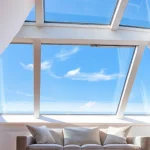Selecting Pool Materials and Finishes
Choosing the right pool materials is crucial to complementing modern architecture. The appeal lies in selecting materials that don’t just stand the test of time but also fuse seamlessly with the home’s architectural style. Often, sleek finishes such as ceramic or glass tiles are favoured, as they enhance the contemporary aesthetics synonymous with today’s housing trends. These options not only contribute to a luxurious feel but are also known for their resilience against weathering.
When it comes to modern finishes, the colour palette is vital. Neutral tones or soft blues and greens are often selected, as they mimic natural elements and create a sense of visual harmony within the space. This encourages a smooth transition between indoor and outdoor areas, making the pool a direct extension of the living environment.
In parallel : Essential Tips to Ensure Your Pool Slide Complies with UK Safety Regulations
Sustainability is another important consideration in material selection. Opting for eco-friendly materials, such as recycled or locally sourced products, can not only reduce the environmental footprint but also enhance the natural aesthetics of the area. By focusing on these aspects, homeowners can achieve a functional, beautiful, and sustainable pool space that resonates with modern design principles.
Understanding Modern UK Architectural Trends
Modern architecture in the UK is defined by clarity, simplicity, and clean lines, often utilising an innovative approach to blending materials. Contemporary styles harmonise functionality with aesthetics, reflecting minimalistic principles. These contemporary styles embrace open-plan layouts and large windows, facilitating light and space for enhanced visibility and connection with surroundings. Innovations in modern architecture prioritise energy efficiency, often seen through sustainable building materials and technologies like solar panels.
Also to see : Revolutionize UK Pool Safety with Innovative Smart Tech Solutions
Key trends in contemporary UK home design include the integration of green technology and sustainable practices. Homes are designed with flexible spaces that adapt to evolving needs, resonating with the urban populace’s lifestyle dynamics. The integration of smart home systems exemplifies the seamless marriage of technology and design, appealing to modern homeowners who value convenience.
Incorporating aesthetics into the fusion of architecture and pool design is crucial. This ensures the pool complements rather than competes with the home. A well-designed space aligns with the architectural style, utilising materials and finishes that match the home’s modern characteristics. The pool often serves as a focal point in these modern homes, showcasing the designer’s attention to aesthetic detail and the homeowner’s preferences for elegance and modernity.
Integrating Landscaping with Pool Design
Incorporating thoughtful landscaping around your pool not only boosts outdoor aesthetics but also provides a sense of design harmony with the surrounding architecture. The seamless blend of natural elements, such as lush greenery and stonework, with the pool area can augment the overall visual appeal, creating a tranquil environment. For instance, strategically placed trees or shrubs deliver not only shade and privacy but also complement the sleek lines seen in modern architecture.
Creating cohesive outdoor spaces involves a careful selection of plants and materials that encourage a natural flow between the pool and garden areas. Opt for native plants as they usually require less maintenance and water, aligning well with sustainable practices. Incorporating features like water fountains or natural rock formations can further echo the clean, minimalistic style of contemporary architectural trends.
To ensure that pool areas align with modern architectural principles, consider using materials like wood decking or stone tiles that resonate with the rest of your home’s facade. In summary, when integrating landscaping with pool design, it’s crucial to maintain equilibrium between natural beauty and design harmony for a distinctive yet consistent aesthetic.
Practical Design Considerations
When designing a pool that complements modern architecture, various factors influence both the pool’s shape and layout. The key is to create a design that mirrors the minimalist and sleek aesthetic of contemporary styles, ensuring that the pool becomes a seamless part of the overall landscape. Curved or geometric shapes often align well with modern themes, offering both visual interest and functionality.
Accessibility plays a crucial role in enhancing homeowner convenience. Features like shallow ledges, integrated seating, and easily accessible steps or ramps can make a pool more user-friendly, particularly important for families or individuals with mobility considerations.
In the UK, the climate is a significant factor influencing pool functionality. For instance, the inclusion of pool covers or heating elements can maintain usability throughout cooler months while protecting the pool from environmental wear. Considering the UK’s diverse weather patterns when selecting materials will ensure durability and lower maintenance.
Design practicality involves a careful balance of aesthetics, functionality, and comfort. By accounting for these elements, and integrating smart design practices, homeowners can enjoy a stylish and practical pool that enhances their outdoor living space while resonating with the surrounding architecture.
Case Studies and Visual Inspiration
Exploring design case studies offers valuable insights into how cutting-edge pool architecture is achieved. A successful project often starts with the perfect synergy between a pool’s form and its surrounding modern architecture. These environments typically emphasise clean lines and smooth surfaces, which are fundamental to UK home design and associated contemporary styles. The aim is to blend natural elements, such as water and light, with these structures.
Notable examples showcase pools that preserve visual flow while maximising functional space. For instance, use of materials like glass and concrete align with minimalist trends, demonstrating how pools can extend living areas outdoors seamlessly. By studying such visual examples, one can extract design elements that not only complement but also elevate architectural features.
To find inspiration, turn to top design professionals who consistently deliver projects reflecting a balance of aesthetics and practicality. Observe the careful selection of materials that sustain both form and function. Additionally, exploring a designer’s portfolio or attending architect-led tours can kindle creativity. Swapping ideas at exhibitions also helps, breathing life into personal space plans. Such insights ensure that pool spaces remain visually captivating and intrinsically practical, embodying longevity and beauty.
Maintenance Tips for Long-lasting Aesthetic Appeal
Maintaining a pool’s aesthetic appeal requires consistent attention to pool maintenance practices and choosing materials that align with longevity goals. Regular cleaning helps sustain the visual charm by preventing debris build-up that can dull surfaces. Prioritising durable finishes like ceramic or glass tiles, which resist fading and weathering, minimises maintenance demands. Consider materials with natural protective coatings to further reduce maintenance efforts.
Seasonal considerations ensure your pool retains its pristine appearance year-round. For example, during autumn and winter, investing in a quality cover protects the pool from debris and temperature fluctuations, preserving both water clarity and surface integrity. Additionally, regular checks for chips or cracks facilitate prompt repairs, preserving the pool’s aesthetic upkeep.
To enhance longevity, establish a routine that incorporates chemical balancing, which protects surfaces from discoloration or corrosion. Addressing issues like algae growth promptly prevents unsightly appearances. Use preventative measures, like placing shade structures, to protect against excessive sun exposure, which can lead to material deterioration over time. By adhering to these strategies, homeowners can enjoy a visually appealing and low-maintenance pool that reflects modern UK home design aesthetics effectively.










